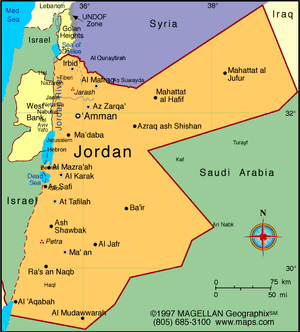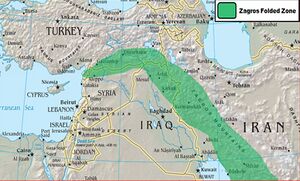Jordan
| Author:Laxman Burdak, IFS (R) |



Jordan(Hindi:जोर्डन; Arabic: الأردن al-Urdun) is an Arab kingdom in Western Asia, on the East Bank of the Jordan River.
Location
Jordan is bordered by Saudi Arabia to the south and east, Iraq to the north-east, Syria to the north, and Israel to the west.
Major cities include the capital Amman and Salt in the west, Irbid, Jerash and Zarqa, in the northwest and Madaba, Karak and Aqaba in the southwest. Major towns in the eastern part of the country are the oasis town of Azraq and Ruwaished.
Administrative divisions
Jordan is divided into 12 provinces known as governorates, which, in turn, are subdivided into 54 departments or districts called nawahi.
The Governorates (capitals) are 1. Irbid (Irbid), 2. Ajloun (Ajloun), 3. Jerash (Jerash), 4. Mafraq(Mafraq), 5. Balqa (Salt), 6. Amman (Amman), 7. Zarqa(Zarqa), 8. Madaba (Madaba), 9. Karak (Al Karak), 10. Tafilah (Tafilah), 11. Ma'an (Ma'an), 12. Aqaba(Aqaba),
History
After the post-World War I division of West Asia by Britain and France, the Emirate of Transjordan was officially recognized by the Council of the League of Nations in 1922. In 1946, Jordan became an independent sovereign state officially known as the Hashemite Kingdom of Transjordan. After capturing the West Bank during the 1948 Arab–Israeli War, Abdullah I took the title King of Jordan. The name of the state was changed to The Hashemite Kingdom of Jordan on 1 December 1948.
In antiquity, the present day Jordan became a home for several Semitic Canaanite-speaking ancient kingdoms, including the kingdom of Edom, the kingdom of Moab, the kingdom of Ammon, the kingdom of Israel and also the Amalekites. Throughout different eras of history, the region and its nations were subject to the control of powerful foreign empires; including the Akkadian Empire (2335-2193 BC), Ancient Egypt (15th to 13th centuries BC), Hittite Empire (14th and 13th centuries BC), the Middle Assyrian Empire (1365-1020 BC), Neo-Assyrian Empire (911-605 BC), the Neo-Babylonian Empire (604-539 BC) and the Achaemenid Empire (539-332 BC) and, for discrete periods of times, by Israelites. The Mesha Stele recorded the glory of the Kings of Moab and the victories over the Israelites and other nations. The Ammon and Moab kingdoms are mentioned in ancient maps, Near Eastern documents, ancient Greco-Roman artifacts, and Christian and Jewish religious scriptures.[1]
Due to its strategic location in the middle of the ancient world, Transjordan came to be controlled by the ancient empires of Persians and later the Macedonian Greeks, who became the dominant force in the region, following the conquests of Alexander the Great. It later fell under the changing influence of the Hellenistic Seleucid Empire from the North and the Parthians from the East.
The Aramaic speaking Nabatean kingdom was one of the most prominent states in the region through the middle classic period, since the decline of the Seleucid control of the region in 168 BC. The Nabateans were most probably people of mixed Aramean, Canaanite and Arabian ancestry, who fell under the early influence of the Hellenistic and Parthian cultures, creating a unique civilized society, which roamed the roads of the deserts. They controlled the regional and international trade routes of the ancient world by dominating a large area southwest of the Fertile Crescent, which included the whole of modern Jordan in addition to the southern part of Syria in the north and the northern part of Arabian Peninsula in the south. The Nabataeans developed the Nabatean Alphabet, a descendant of the Aramaic alphabet, which was eventually to lead to the formation of the Arabic Script in the 4th century AD.[2] Their language was originally Aramaic (a West Semitic language), but became infused with South Semitic Arabic with the migration of Arab tribes into Nabatea in the 3rd and 4th centuries AD.[3] It acted as an intermediary between Aramaean and Classical Arabic, the latter of which evolved into Modern Arabic.
The Nabateans were largely conquered by the Hasmonean rulers of Judea and many of them forced to convert to Judaism in the late 2nd century BC. However, the Nabataeans managed to maintain a sort of semi-independent kingdom, which covered most parts of modern Jordan and beyond, before it was taken by the Herodians and finally annexed by the still expanding Roman Empire in 106 AD. However, apart from Petra, the Romans maintained the prosperity of most of the ancient cities in Transjordan which enjoyed a sort of city-state autonomy under the umbrella of the alliance of the Decapolis. Nabataean civilization left many magnificent archaeological sites at Petra, which is considered one of the New 7 Wonders of the World as well as recognized by the UNESCO as a World Heritage Site.
Following the establishment of Roman Empire at Syria, the country was incorporated into the client Judaean Kingdom of Herod, and later the Judaea Province. With the suppression of Jewish Revolts, the eastern bank of Transjordan was incorporated into the Syria Palaestina province, while the eastern deserts fell under Parthian and later Persian Sassanid control. During the Greco-Roman period, a number of semi-independent city-states also developed in the region of Transjordan under the umbrella of the Decapolis including: Gerasa (Jerash), Philadelphia (Amman), Raphana (Abila), Dion (Capitolias), Gadara (Umm Qais), and Pella (Irbid).
With the decline of the Eastern Roman Empire, Transjordan came to be controlled by the Christian Ghassanid Arab kingdom, which allied with Byzantium. The Byzantine site of Umm ar-Rasas is a UNESCO World Heritage Site.
Jat History
Prof. B.S. Dhillon[4] writes that According to Herodotus[5] Scythians also invaded Syria and Judea (part of modern Israel and Jordan) in 625 B.C. and subsequently reached the boundaries of Egypt. Its King called Psamtik I (663-610 B.C.) checked their advance by purchasing peace on their terms.
DNA study on Y-STR Haplogroup Diversity in the Jat Population
David G. Mahal and Ianis G. Matsoukas[6] conducted a scientific study on Y-STR Haplogroup Diversity in the Jat Population of which brief Conclusion is as under:
The Jats represent a large ethnic community that has inhabited the northwest region of India and Pakistan for several thousand years. It is estimated the community has a population of over 123 million people. Many historians and academics have asserted that the Jats are descendants of Aryans, Scythians, or other ancient people that arrived and lived in northern India at one time. Essentially, the specific origin of these people has remained a matter of contention for a long time. This study demonstrated that the origins of Jats can be clarified by identifying their Y-chromosome haplogroups and tracing their genetic markers on the Y-DNA haplogroup tree. A sample of 302 Y-chromosome haplotypes of Jats in India and Pakistan was analyzed. The results showed that the sample population had several different lines of ancestry and emerged from at least nine different geographical regions of the world. It also became evident that the Jats did not have a unique set of genes, but shared an underlying genetic unity with several other ethnic communities in the Indian subcontinent. A startling new assessment of the genetic ancient origins of these people was revealed with DNA science.
The human Y-chromosome provides a powerful molecular tool for analyzing Y-STR haplotypes and determining their haplogroups which lead to the ancient geographic origins of individuals. For this study, the Jats and 38 other ethnic groups in the Indian subcontinent were analyzed, and their haplogroups were compared. Using genetic markers and available descriptions of haplogroups from the Y-DNA phylogenetic tree, the geographic origins and migratory paths of their ancestors were traced.
The study demonstrated that based on their genetic makeup, the Jats belonged to at least nine specific haplogroups, with nine different lines of ancestry and geographic origins. About 90% of the Jats in our sample belonged to only four different lines of ancestry and geographic origins:
1. Haplogroup L (36.8%)- The origins of this haplogroup can be traced to the rugged and mountainous Pamir Knot region in Tajikistan.
2. Haplogroup R (28.5%): From somewhere in Central Asia, some descendants of the man carrying the M207 mutation on the Y chromosome headed south to arrive in India about 10,000 years ago (Wells, 2007). This is one of the largest haplogroups in India and Pakistan. Of its key subclades, R2 is observed especially in India and central Asia.
3. Haplogroup Q (15.6%): With its origins in central Asia, descendants of this group are linked to the Huns, Mongols, and Turkic people. In Europe it is found in southern Sweden, among Ashkenazi Jews, and in central and Eastern Europe such as, the Rhône-Alpes region of France, southern Sicily, southern Croatia, northern Serbia, parts of Poland and Ukraine.
4. Haplogroup J (9.6%): The ancestor of this haplogroup was born in the Middle East area known as the Fertile Crescent, comprising Israel, the West Bank, Jordon, Lebanon, Syria, and Iraq. Middle Eastern traders brought this genetic marker to the Indian subcontinent (Kerchner, 2013).
5.-9. Haplogroups E, G, H, I, T (9.5%): The ancestors of the remaining five haplogroups E, G, H, I, and T can be traced to different parts of Africa, Middle East, South Central Asia, and Europe (ISOGG, 2016).
Therefore, attributing the origins of this entire ethnic group to loosely defined ancient populations such as, Indo-Aryans or Indo-Scythians represents very broad generalities and cannot be supported. The study also revealed that even with their different languages, religions, nationalities, customs, cuisines, and physical differences, the Jats shared their haplogroups with several other ethnic groups of the Indian subcontinent, and had the same common ancestors and geographic origins in the distant past. Based on recent developments in DNA science, this study provided new insights into the ancient geographic origins of this major ethnic group in the Indian subcontinent. A larger dataset, particularly with more representation of Muslim Jats, is likely to reveal some additional haplogroups and geographical origins for this ethnic group.
जर्तगण
डॉ. धर्मचंद्र विद्यालंकार[7] ने लिखा है....महर्षि यास्काचार्य ने ही तो जरितों किंवा जर्तों को ही गर्तास्यु भी बताया है; अर्थात वही जर्तगण भूतल में भवन बना कर भी नित्य निवास किया करते हैं. मध्यपूर्व के जार्डन (जर्तायन) जैसे देश के प्रेत (प्रेटा) नामक नगर में ईसा पूर्व प्रथम सहस्त्राब्दी के ऐसे ही शैलाश्रय उत्खनन में मिले हैं. जिनमें विधिवत रूप से ही पर्वत मालाओं को काट-काट कर भव्य स्तम्भ-संयुक्त विशाल गृह और आवास भवन बनाए हुए हैं. यह स्थान वर्तमान में मानव की आदिम भवन संबंधी संरचना है. लगभग उसी काल के यास्काचार्य यही हमें बता रहे हैं कि जर्त या जाट लोग ही भूतल में घर बना कर रहा करते थे.
Risaldar Badlu Singh fights war on River Jordan

Risaldar Badlu Singh VC, (b.November 1876-d.23 September 1918), Dhankhar Jat from village Dhakla district Jhajjar (Haryana), was an Indian recipient of the Victoria Cross, the highest and most prestigious award for gallantry in the face of the enemy that can be awarded to British and Commonwealth forces.
He was a Risaldar in the 14th Murray's Jat Lancers, Indian Army, attached to 29th Lancers (Deccan Horse) during the First World War when the following deed took place for which he was awarded the VC.
On 23 September 1918 on the west bank of the River Jordan, Palestine, when his squadron was charging a strong enemy position, Risaldar Badlu Singh realised that heavy casualties were being inflicted from a small hill occupied by machine-guns and 200 infantry. Without any hesitation he collected six other ranks and with entire disregard of danger he charged and captured the position. He was mortally wounded on the very top of the hill when capturing one of the machine-guns single handed. But, before he fell, all the guns and infantry had surrendered to him.
"His valour and initiative were of the highest order." (London Gazette, 27 November 1918)
He was Killed during his VC action on 23 September 1918.
External links
- Official website of the Hashemite Kingdom of Jordan
- Official website of the Embassy of India in Amman
References
- ↑ "Edom". BiblePlaces.com.
- ↑ Nabataean abjad.
- ↑ Basalt, 1st century AD. Found in Sia in the Hauran, Southern Syria.
- ↑ History and study of the Jats/Chapter 2,p.33
- ↑ The Histories, Penguin Books, Inc., London, 1988, pp. 272-273, 122128, 467.
- ↑ Y-STR Haplogroup Diversity in the Jat Population Reveals Several Different Ancient Origins
- ↑ Patanjali Ke Jartagana or Jnatrika Kaun The,p.14

